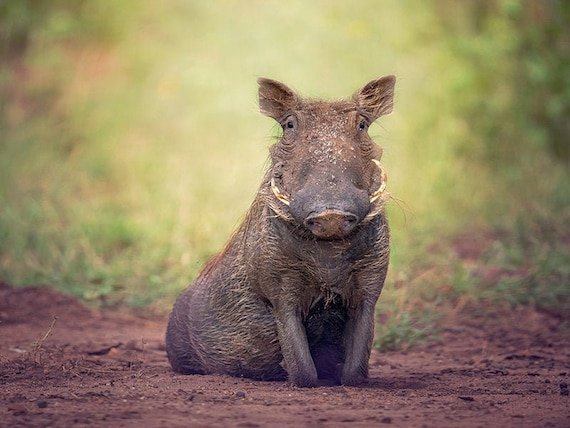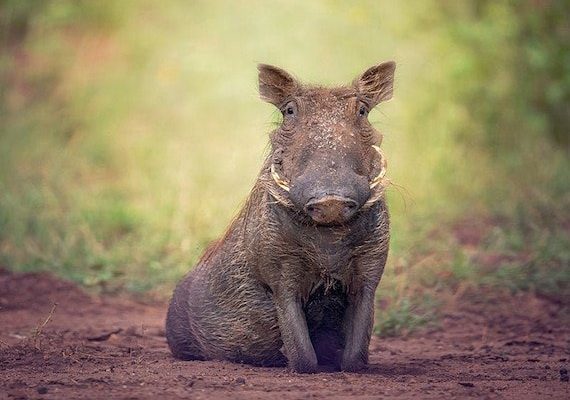
Imagine navigating a dry landscape where water is scarce, food is hard to find, and predators are lurking. It sounds challenging, right? But warthogs have some clever tricks up their sleeves. They’ve developed behaviors and traits that help them dodge danger and stay nourished, even when the going gets tough. So, let’s dive into the world of warthogs and explore how these remarkable animals survive in their demanding habitats.
Physical Adaptations for Survival
Warthogs are built tough, and their physical features play a big role in how they endure harsh environments. First off, their **thick skin** acts like armor, protecting them from thorns and sharp grasses. This is important in areas where they have to foraging through dense brush. You might picture them like rugged explorers, pushing through prickly obstacles to find a meal.
Another key feature is their **tusks**. These aren’t just for show; they serve as essential tools for male warthogs, especially during fights for territory or mating rights. Additionally, females use them to dig for roots and bulbs, which are crucial food sources in dry seasons. Think of their tusks as Swiss Army knives—they help with eating, defending, and even navigating tough terrain.
Their **large, flat feet** are also worth mentioning. Unlike many other animals, warthogs have distinctively adapted feet that help them run fast on uneven ground. This speed is essential when evading predators like lions and hyenas. It’s like having built-in sneakers designed for sprinting away from danger!
Behavioral Adaptations: Teamwork in the Wild
Warthogs are social animals that often stick together in small groups. This teamwork is a smart survival strategy. By staying in groups, they can keep a lookout for predators. If you’ve ever watched a movie where the heroes band together to face challenges, it’s kind of like that!
When they sense danger, a warthog won’t hesitate to make a run for it, but they first look out for each other. They communicate through a variety of sounds, letting the group know when it’s time to go. You might say they have a built-in alarm system, alerting each other about what’s happening nearby.
In addition to staying in groups, you’ll often find warthogs wallowing in mud. This behavior isn’t just for fun; it actually helps regulate their body temperature. In the sweltering heat, a mud bath cools them down and protects their skin from sunburn and insects. Think of mud as their natural sunscreen!
Finding Food and Water: Nature’s Challenges
One of the toughest challenges for warthogs is finding food and water. In areas where vegetation is sparse, they’ve become expert foragers. They’re not picky eaters, which definitely helps their survival. Warthogs eat a mix of grasses, roots, and even fruits when available.
During the dry seasons, water can be particularly hard to come by. Warthogs have a sharp nose and keen sense of smell, allowing them to sniff out underground water sources. They can dig into the ground with their powerful snouts, like using a shovel to unearth hidden treasures! It’s fascinating how they adapt their foraging techniques based on the seasons and available resources.
Here’s an interesting tidbit: when food is abundant, warthogs will often store extra food by burying it in the ground. This clever tactic helps them access meals later, much like you might stash away snacks for a rainy day. It’s a survival strategy that ensures they don’t go hungry when resources become scarce.
Adapting to Predation: Outsmarting the Threats
Every creature in the wild faces threats, and warthogs are no exception. They are prey for larger carnivores, so their survival instincts kick in. Warthogs have developed several strategies to outsmart potential threats. For one, they are incredibly alert and always on the lookout. Their heads are often raised, scanning their surroundings for any signs of danger.
Another fascinating behavior is their response to danger. When threatened, warthogs might run away, but they also have a unique defense mechanism: they will often run towards their burrows or dens. This can be a safe haven where they can hide from predators. It’s like knowing where your safe spot is when playing hide and seek!
Additionally, when caught in the open, warthogs can display aggression by charging at their enemies. This boldness is often surprising considering their goofy appearance. Yet, it’s a vital part of their defense strategy. It’s like standing your ground when faced with a bully—sometimes, showing confidence can deter a threat.
Environmental Challenges: Climate and Habitat
Warthogs are native to the African savannah, a place known for its diverse climate and vast landscapes. However, this environment can be unforgiving. During dry seasons, temperatures can soar, and water can become incredibly scarce. To cope with these extremes, warthogs are tough as nails, but they also have to be smart about where they live.
You might find them in grassy plains or wooded areas, which offer some shade and food resources. They often seek out areas close to water sources, like rivers and lakes, even if it means sharing their space with other animals. It’s a classic case of “you gotta do what you gotta do” to survive.
The changing environment also means that warthogs must adjust their habits. For instance, they might forage more during the cooler parts of the day, like early morning or late afternoon. It’s like adjusting your routine to avoid the harsh midday sun. Keeping these simple yet effective strategies in mind helps them navigate their surroundings successfully.
Conservation Efforts: Protecting Warthogs
While warthogs are well-equipped to survive, they still face threats from habitat loss, hunting, and climate change. Conservation efforts are crucial to ensure these remarkable animals continue to thrive. Many wildlife organizations are working hard to protect their habitats and educate the public about the importance of preserving biodiversity.
In protected areas, warthogs can find refuge from poaching and habitat degradation. National parks and reserves play a vital role in safeguarding their populations, allowing them to roam freely and continue their unique survival story. Community-based conservation initiatives also encourage local people to protect these animals by promoting eco-friendly tourism.
Honestly, every little effort counts. By supporting conservation programs, we can help safeguard the future of warthogs and their ecosystems. After all, they play a vital role in maintaining the balance of their habitat—ensuring that the circle of life continues.
In conclusion, warthogs are extraordinary animals that have adapted to thrive in harsh environments through physical and behavioral strategies. Their resilience, clever foraging skills, and social structures enable them to navigate the challenges of their habitat. As we continue to learn more about these fascinating creatures, let’s take a moment to appreciate their place in the natural world and the importance of protecting their future.

